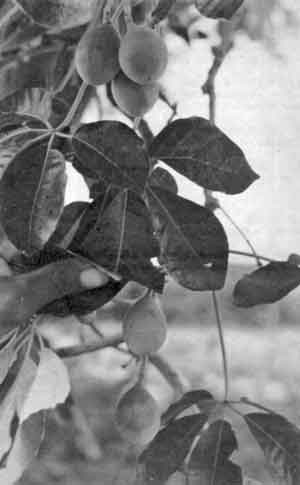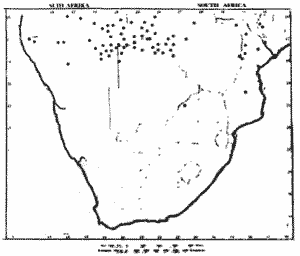
MANKETTI
SCIENTIFIC NAME: Ricinodendron rautanenii
FAMILY: Euphorbiaceae
Other common names: Manketti nut tree, Mugongo (Ov, W. Caprivi, Deiriku), omungeta (Her), ngongo (Kawango, Deiriku).
Derivation of name: Ricinus = genus to which the castor oil plant belongs; dendron = tree; Rautanen, Finnish missionary who collected plants in Ovambo region.
(* Editor's note: the genus name has been changed from Ricinodendron to Schinziophyton.)
Diagnostic features: Large deciduous tree. Bark smooth, flaking in thin flakes, grey-green to mottled reddish-brown. Leaves alternate, palmately compound with 5-7 large, short-stalked leaflets. Fruit about the size and shape of a plum, containing a large nut-like stone.
Description: Tree up to 15m high with broad crown and straight bole up to 1 m in diameter. Leaves borne at ends of young twigs, stalks up to 15cm long with two large green glands on the tip, leaflets 5-12cm long, ovate to broadly elliptic with asymmetric base, margins beset with small scattered green glandular teeth. Inflorescence: Male and female inflorescences borne on different trees; male inflorescences are slender, few-flowered panicles up to 15cm long; female panicles with very few flowers and much shorter than the male. Male flowers 9mm long; sepals 4-5, yellow, densely tomentose with stellate hairs; petals 5, fused for almost their entire length into a wide, glabrous tube; stamens 15-16, free, hairy at the base. Female flowers 12mm long; sepals and petals the same length and very similar to those of the male flower; ovary 1-3 chambered, with a single ovule in each chamber. Fruit drupaceous, ellipsoid, about 3.5cm long, 2.5cm in diameter, reddish-brown when ripe; outer skin thin, tough; flesh whitish-brown, sweetish; endocarp woody, porous, divided by a chamber which separates the endocarp into two portions except at the base and apex. Seeds usually 1 or 2, with hard testa and copious, oily endosperm. Relationships: 5 species of Ricinodendron occur in Africa but only R. rautanenii is found in Southern Africa. Flowering, Fruiting, Leafing: The manketti flowers from October to December. Ripe fruit are found during autumn and winter. The fruits ripen on the tree and are shed usually together with the leaves. |  |
|
Ricinodendron rautanenii Tree with fruit (Photo taken by Hans Muller) |
Ecology and Distribution: It is most commonly found on deep Kalahari sands and sometimes on limestone outcrops. The tree also grows on sandy alluvial soils near rivers or omurambas (SWA).
It occurs in open woodlands, often in association with Terminalia sericea, Burkea africana, Pterocarpus angolensis, Baikiaea plurijuga, Guibourtia coleosperma, Strychnos cocculoides, Afzelia quanzensis and Combretum spp. The manketti is often gregarious and can be found in large stands, some up to 60,000 hectares in extent, where they are the dominant tree species spaced about 20m apart. A few dozen plants are found in northwestern Transvaal on a patch of Kalahari sand.
Uses: The mass of the entire fruit is about 10g. The outer skin constitutes about 10% of the fruit, the flesh inside it, surrounding the so-called nut, about 20%. The outer shell (endocarp) of the nut is extremely hard and tough. Inside the outer shell is the thin inner shell (testa) which adheres firmly to the soft, cream-coloured kernel which constitutes about 10% of the entire fruit.
The fruits are used by Bantu and Bushmen wherever the tree grows. In some areas, where it occurs prolifically, it is used as a staple food especially during dry years. To certain Bushman tribes the nuts are the mainstay of their vegetable diet. After cooking, the whole fruit the outer skin is removed and a porridge or soup made from the flesh, which has a pleasant aromatic flavour and a sweet taste which is due to a high sugar content. The outer skin is not eaten since it is tough and rather indigestible.
The dry crumbly flesh from old fruits is also edible, raw or cooked. Sometimes the flesh from fresh fruit is collected, dried and stored away for later use. It does not readily go bad and retains its flavour and sweet taste.
The kernels have a pleasant taste, can be eaten raw or roasted, and could be marketed as a luxury item similar to cashew nuts, provided that suitable machines can be developed to crack the nuts in such a way that the kernels can be extracted more or less intact.
With machinery available at present, the nuts can, however, be successfully cracked for the extraction of oil. During 1911 to 1914, about 2000 tons of nuts were exported annually from the Tsumed forests in South West AFrica to Germany and in 1916 similar quantities were shipped to England for the production of margarine. In Angola the oil was at one time extracted on a small scale for commercial use.
In 1914 it was estimated that the Tsumed forest produced an average annual crop of about 1 ton of nuts per hectare. It was pointed out, however, that the production of nuts depended largely on the annual rainfall. In any scheme for the utilization of naturally growing nuts, their importance as a natural source of food for the local population must be taken into consideration.
The wood is whitish or pale-yellowish, soft and light, (weighing 560 kg/m3 green, and 240 kg/m3 air-dry), and has been used for pattern-making, backing of furniture, packing cases, floats and insulating material. It has also been used for paper making, but is also reported as being unsuitable for this purpose.
Because of its economic potential, thought should be given towards the establishment of cultivated stands of manketti.
Cultivation: The manketti may be propagated by means of seed and truncheon-cuttings, but this matter should be further investigated before large scale plantings are attempted.
Anatomy and cytogenetics: Virtually nothing is known about its anatomy. Chromosome number of the genus Ricinodendron: X=11.
 | LITERATURE ANON, no date. Herbarium notes, National Herbarium, Pretoria. Unpublished. DYER, R.A.1975. The general of Southern African flowering plants. Vol.1 Pretoria. Govt.Printer. STORY, R. 1958. Some plants used by the Bushmen in obtaining food and water. Mem.Bot.Surv.S.Afr.25 THISELTON-DYER, W.T. 1912. Flora of Tropical Africa. 6, 1, 4. Ashford: Reeve. WATT, J.M. and BREYER-BRANDWIJK, M.G., 1962. Medicinal and poisonous plants of southern and eastern Africa. 2nd ed. Edinburgh and London: Livingstone. WHITE, F. 1962. Forest flora of Northern Rhodesia. Oxford: University Press. Article by J. Vahrmeijer - Southern African Plants No.4463,000-0010(1976) |
| Manketti areas in South Africa |
THE NUTRIENT COMPOSITION OF MANKETTI FRUIT
The nutrient composition of the fruit (flesh and kernel is given in Table 1 and represents the average values obtained on fruits from Botswana and South West Africa. The standard chemical and physico-chemical methods used in the Food Chemistry Division of the National Food Research Institute of the Council for Scientific and Industrial Research were used for the analysis of the fruits.
TABLE 1
Chemical composition of the fruit.
| Dry Flesh | Kernel | |
| *Moisture | 8.4 | 4.2 |
| *Ash | 5.6 | 4.1 |
| *Protein (Nx6.25) | 9.4 | 26.0 |
| *Fat (petroleum ether extract) | 1.2 | 57.3 |
| *Fibre | 2.5 | 2.5 |
| *Sucrose | 29.8 | |
| *Glucose | 0.2 | |
| *Fructose | 0.5 | |
| *Total carbohydrate (by difference) | 72.9 | 5.9 |
| Energy value (kJ per 100g) | 1424 | 269 |
| **Calcium | 104 | 193 |
| **Magnesium | 266 | 527 |
| **Iron | 4.30 | 3.70 |
| **Copper | 1.6 | 2.82 |
| **Zinc | 1.79 | 4.09 |
| **Sodium | 1.86 | 3.10 |
| **Potassium | 2666 | 673 |
| **Phosphorus | 62.0 | 845 |
| **Thiamine | 0.49 | 0.31 |
| **Riboflavin | 0.21 | 0.21 |
| **Nicotinic acid | 4.79 | 0.31 |
| **Vitamin C | 14.7 | --- |
| **α-Tocopherol) Vitamin E | 29 | |
| **γ-tocopherol) | 536 | |
| * g/100g ** mg/100g | ||
| Amino Acids | ||
| Aspartic acid | 0.4 | 2.4 |
| Threonine | 0.2 | 1.0 |
| Serine | 0.3 | 1.3 |
| Glutamic Acid | 0.7 | 4.2 |
| Proline | 0.2 | 1.2 |
| Glycine | 0.2 | 1.2 |
| Alanine | 0.4 | 1.0 |
| Half cystine | --- | 0.1 |
| Valine | 0.2 | 1.8 |
| Methionine | trace | 0.4 |
| Isoleucine | 0.2 | 0.7 |
| Leucine | 0.2 | 1.4 |
| Tyrosine | 0.1 | 1.3 |
| Phenylalanine | 0.2 | 1.3 |
| Lysine | 0.2 | 0.7 |
| Histidine | 0.1 | 0.7 |
| Arginine | 0.7 | 3.5 |
| * g/100g | ||
Fatty Acids
(percentage of total acid content)
| Palmitic Acid | 9.5 |
| Stearic Acid | 7.6 |
| Oleic Acid | 17.7 |
| Linoleic Acid | 42.9 |
| Arachidic Acid | 0.6 |
| α + β Eleostearic Acid | 21.7 |
The dry flesh is a good source of minerals and contains protein and B vitamins in about the same proportion as a cereal such as wheat. The protein, oil and mineral content of the kernel is high. The oil contains a high percentage of the essential fatty acid 'linoleic acid', and the eleostearic acid content is fairly high. Since the unsaturated fatty acid content of the oil is high the oil could be used as a drying oil in the paint industry but the γ-tocopherol would then first have to be removed. Due to the high γ tocopherol content, the oil is remarkably stable against oxidation.
The edible portion of a fruit is: dry flesh and kernel about 3g and 1.4g respectively. Assuming that all of the nutrients as determined are available, an adult man eating 100 of the fruits daily (i.e. 300g flesh and 140g kernel) would get the following percentages of his daily dietary allowance:
| Energy | 71 |
| Protein | 115 |
| Vitamin E activity (α-tocopherol) | 400 |
| Vitamin C | 98 |
| Nicotinic acid | 82 |
| Riboflavin | 58 |
| Thiamine | 136 |
| Calcium | 72 |
| Magnesium | 438 |
| Iron | 100 |
| Zinc | 74 |
| Phosphorus | 148 |
Published by the Botanical Research Institute, Pretoria and obtainable from the Division of Agricultural Information, Private Bag X144, Pretoria 0001.
LITERATURE
ANON, 1973. Recommended daily dietary allowances (revised 1973). Food and Nutrition Board, National Academy of Sciences - National Research (USA).
LEE, R. B. 1973. Mongongo: The ethnography of a major wild food resource. Ecology of food and nutrition. Vol. 2 (1973).
VIDAL, V. A. C. et al. 1962. Oleaginosas do Ultramar Portugues. Vol 2 No.31. Memorias da Junta de Investigacdos do Ultramar. Lisbon (1962).
DATE: May 1988
* * * * * * * * * * * * *
